We love Mark Bradford!
Teaching Programs and Partnerships staff with Mark Bradford. An exhibition spanning ten years of his career opens at the DMA on October 16th.
Official behind-the-scenes blog of the Dallas Museum of Art
We love Mark Bradford!
Teaching Programs and Partnerships staff with Mark Bradford. An exhibition spanning ten years of his career opens at the DMA on October 16th.
Detail, the massive ark currently grounded in the Barrel Vault, recreates part of Mark Bradford’s earlier work Mithra which was installed in New Orleans after hurricane Katrina. Detail consists of a steel and wood core to which is attached plywood panels to form the outer hull. The only part of the original Mithra that is used for this new piece is the outer plywood hull; the inner structure is new and was designed and fabricated for Bradford’s retrospective.
Because of the size and complexity of Detail, it was decided early in the planning stages of our exhibit that I would travel to Chicago to observe the piece being installed at the Museum of Contemporary Art. Being able to watch and participate in the assembly of Detail at the MCA answered most of the questions we had about its construction. Well before we began our installation, we had a very firm idea of how the piece would go together and how long it would take to build.
The first two days of installation were spent bolting together the inner steel core, which comprises thirteen steel uprights, sixteen corrugated steel panels, and almost forty horizontal and diagonal braces. Due to the size and weight of the individual components, and the fact that the steel panels were an extremely tight fit to the uprights, this was the most difficult part of the installation. The prep staff made judicious use of rubber mallets to “persuade” the steel panels to fit. When completed, this inner core replicates the look of the steel shipping containers used in the original Mithra. Detail is designed so that the viewer can get a slight glimpse of this inner structure through small gaps between the plywood panels that form the hull.
Once we were finished assembling the steel core, the installation went fairly quickly. The next step was to attach eleven large wooden “ribs”—each in two sections, a top and a bottom—that bolted on to flanges on the steel uprights. At this point what had been a huge steel box began to take on the shape of a giant boat. Next a series of horizontal wooden braces were screwed between the ribs. These horizontal braces, along with the wooden ribs, served as attachment points for the outer plywood “skin” that forms the hull of Detail. The final step was screwing the plywood panels to the ribs and horizontal braces, which completed the hull. The fit of the panels was not really precise; at this stage, we relied on our own aesthetic judgment, plus images from the installation in Chicago, to determine the exact placement and alignment of each panel in relation to the others around it.
We completed Detail in five days, right on schedule. Mark Bradford’s monumental boat and the Barrel Vault space seem to be made for each other, and Detail will certainly be as memorable a viewing experience as it was to install.
Mike Hill is a Preparator at the Dallas Museum of Art.
Mark Bradford opens this Sunday, October 16 at the Dallas Museum of Art and you do not want to miss this exhibition. Bradford’s abstract, large-scale, mixed-media paintings look beautiful and comfortable in the expansive contemporary art galleries at the DMA. As you plan your own visit or a visit for your students, there is great information about Bradford, his work, and his process available on several websites. Spend some time with the following resources to learn more about Bradford and to gather ideas for dialogue and studio projects with your students.
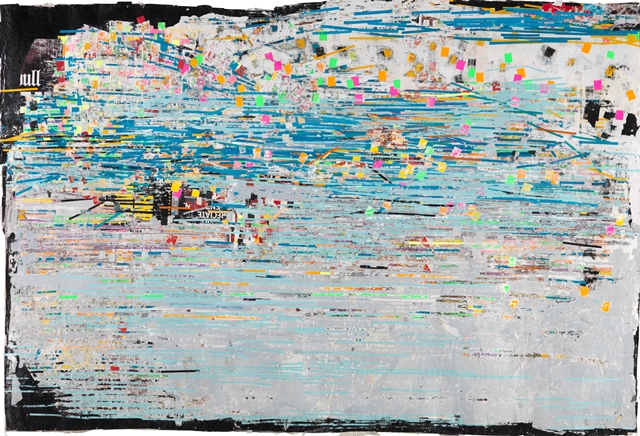
Potable Water, 2005, Billboard paper, photomechanical reproductions, acrylic gel medium, and additional mixed media, 130 x 196 inches, Collection of Hunter Gray, Photo: Bruce M. White
1. Pinocchio is On Fire
This is the official website for the exhibition Mark Bradford, organized by the Wexner Center for the Arts in Ohio. When you visit the site, you have four ways to dive into Bradford’s work. Select “the studio” and view a unique presentation of two videos featuring Bradford talking about his process. “The art” guides us through a look at several works in the exhibition. Finally, you can choose “the artist” to learn more about Bradford’s biography, or select “process & materials” to learn more about what media he uses and how he creates.
2. Art21
This popular PBS documentary about art in the 21st century features Mark Bradford and eighty-five additional contemporary artists presently working in the United States. Each season of Art21, which is now in its fifth season, explores several thematic episodes that bring together multiple artists for consideration within the specified theme. Bradford is featured in the “Paradox” episode, season four, which looks at how contemporary artists address contradiction, ambiguity, and truth. For Bradford and each of the artists featured on the website, visitors can access videos, slideshows, interactive resources, and educational materials.
4. Exhibition smARTphone tour
If you are coming to the exhibition or wish to reconnect with the artworks after visiting the exhibition, don’t forget that you can pull out your smartphone (iPhones, Androids, Blackberrys, etc.) and listen to Mark Bradford talk about several works in the exhibition. This tour has been available at many of the exhibition venues. If you do not have a smartphone, just type “www.dallasmuseumofart.mobi” into your internet browser to view the resources on your computer. Select “Mark Bradford,” then select the artwork of your choice to listen.
Nicole Stutzman
Director of Teaching Programs and Partnerships
If you’re a follower of the DMA Educator Blog, then you’ve read about our Staff Reading Group. Last Friday, our reading group combined a work of fiction with works from the collection in an engaging and provocative conversation.
Melissa selected five excerpts from Einstein’s Dreams by Alan Lightman.* The novel imagines what Einstein may have been dreaming about during the time that he was developing the theory of relativity. Our instructions from Melissa were simple: read the excerpts, each of which offers a definition of time, and select one work of art from the collection to illustrate that definition. This idea was first introduced by Amy in a blog post over the summer.
Six staff members participated in the conversation, and we were shocked when we learned that we had each responded to the same excerpt: 14 April 1905. In this chapter, time is defined in the following way: “Suppose time is a circle, bending back on itself. The world repeats itself, precisely, endlessly” (Lightman, 6).
Both Hannah and Melissa selected Shiva Nataraja as the art equivalent of time as a circle. Shiva is the Hindu deity of creation, destruction, and rebirth, and in this sculpture he dances out the rhythm of the universe.
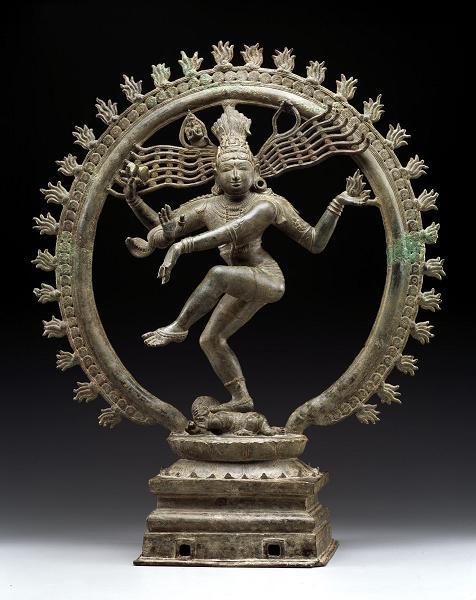
Shiva Nataraja, India, 11th century, Dallas Museum of Art, gift of Mrs. Eugene McDermott, the Hamon Charitable Foundation, and an anonymous donor in honor of David T. Owsley, with additional funding from The Cecil and Ida Green Foundation and the Cecil and Ida Green Acquisition Fund
Our part-time intern, Mary Nangah, thought Jackson Pollock’s Cathedral best represented this concept of time. It’s difficult to identify and starting and ending point for each line. Time is also represented through the repetition of color and line on the canvas.
Jessica selected Harry Koerner’s June Night, which shows an intimate view of an apartment complex. Jessica felt that these vignettes could happen any time, anywhere. The images of the bride and groom, as well as the baby, also reminded her of the cycle of life. The final line of this excerpt reads “For in each town, late at night, the vacant streets and balconies fill up with their moans” (Lightman, 9). Jessica could imagine hearing sorrowful moans on the fire escape of this painting.
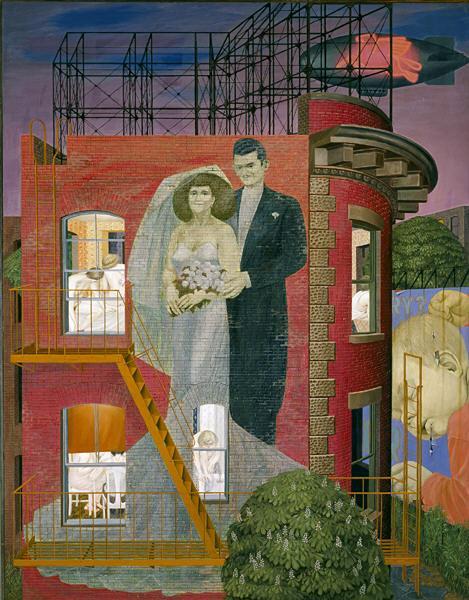
Henry Koerner, June Night, 1948-1949, Dallas Museum of Art, Foundation for the Arts Collection, gift of Joshua L. Logan
My selection was Apollo and Diana Attacking the Children of Niobe by Jacques-Louis David. I was especially struck by the last paragraph of the reading, which was about people with unhappy lives who realize that they cannot change their actions and their mistakes will be repeated over and over again. Here, Niobe pleads with Apollo and Diana to spare the last of her fourteen children from death. She is being punished for her pride after boasting that her children were more beautiful and strong than Apollo and Diana. Her final punishment comes when she is turned into a sculpture, forced to mourn for eternity.
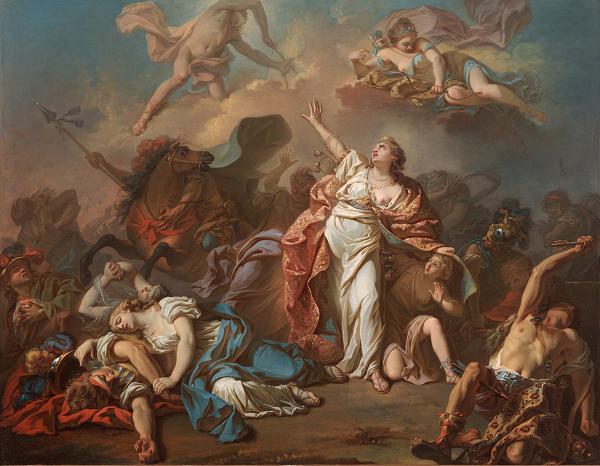
Jacques-Louis David, Apollo and Diana Attacking the Children of Niobe, 1772, Dallas Museum of Art, Foundation for the Arts Collection, Mrs. John B. O'Hara Fund in honor of Dr. Dorothy Kosinski
If you were going to select one work of art from the DMA’s collection to represent time as a circle, what work would you choose? I look forward to reading your responses in the comments!
Shannon Karol
Manager of Docent Programs and Gallery Teaching
*Alan Lightman, Einstein’s Dreams, New York: Vintage Books, 1993.
October is Art Beyond Sight Awareness month and our Family Experiences and Access Programs throughout the month are all about exploring works of art without using vision. How might we do such a thing? By using our other senses! During Art Beyond Sight programming, you might:
HEAR John Bramblitt talk about his works of art and his process of painting as an artist who is blind. In the galleries, spend time imagining how a work of art might sound during one of the ABS programs.
SMELL textured paint as you use your fingers to paint a raised line drawing during a blindfolded painting workshop. Or, you could visit Arturo’s Nest in the Center for Creative Connections to smell spicy notes of cinnamon in one of the sensory bins.
FEEL raised dots as you learn how to write your name in Braille to make a work of art in our family workshop with artist Leslie Ligon. Use your sense of touch to feel mystery textures hidden in a tactile box before drawing it with lines you can feel!
Imagine what you might TASTE while exploring still lifes with food in the European galleries or stretch your mind to imagine how different colors would taste in the Contemporary Art galleries.
Join us throughout the month of October to SEE art without vision!
Amanda Blake is the Manager of Family Experiences and Access Programs.
Who said it???
You’ve seen these artists express themselves with brushstroke, line, paint, and color, but have you ever heard them express themselves with words? Do these two forms of expression match up?
Play my game to see if you can match the art work to the art word!
Below you will find a list of quotes straight from the mouth of some of the masters of modern and contemporary art. Following the quotes are images of artworks by these artists in the DMA collection. They have been all mixed up, so it is up to you to pair the quote and the artist. I will reveal the answers next week in the comments section of this post.
Good luck!
Hannah Burney
McDermott Intern for Teaching Programs
The focus on creativity this month includes a wealth of information to provoke further thoughts. University of Texas at Dallas professor and creativity specialist Magdalena Grohman shares notes from a recent conference she attended.
Have you ever wondered what would happen if we didn’t have a definition of creativity? One crucial implication is that we wouldn’t know how to recognize creativity or how to identify it in a given domain or across different domains. What does creativity look like in science? Math? Language Arts? Without knowing who is or is not creative, we would not be able to list factors that may impede or enhance creative development. Here’s what I learned from my colleagues in the Division 10: Society for the Psychology of Aesthetics, Creativity and the Arts, during the 2011 American Psychological Association Convention.
So, let’s assume we understand creativity as an interaction between aptitude, thinking process, and environment. How does that definition help us identify creative talent?
THINKING PROCESS
Researcher and educator Dr. Roberta Milgram of Ariel University of Samaria, Israel, may have a couple of suggestions for you. In her talk “Identifying Talent in Mathematics and Science in Children, Adolescents, and Adults,” Dr. Milgram showed findings suggesting that each talent has two components: academic and creative. For example, for students to do well in math, they need to show mathematical reasoning and they need to know how to compute. But, according to Dr. Milgram, those students who are mathematically gifted also show that they can notice patterns and relationships and use complex and non-algorithmic thinking. Most importantly, they can apply original thinking with mathematical symbols that results in more than one strategy and/or solution. Let’s consider another domain—take language arts, for instance. A student that has a knack for language arts will not only show great reading comprehension and writing skills, but on top of that, s/he will also be quite observant and notice patterns and relationships, as well as similarities between remote concepts. In other words, s/he will experiment with concepts to come up with new and original ideas. This experimentation and creative thinking belongs to the thinking process portion of the definition of creativity. Skill, ability, motivation, and deep task commitment relate to aptitude. The take home message? Look closely for skills and intellectual ability AND for original and unorthodox thinking patterns that lead to unique ideas and solutions.
APTITUDE
Aptitude also “contains” our attitude towards creativity, which can be shaped by our self-perception. It turns out that whether we see ourselves as creative people depends on gender. These self-perceptions are different in girls and boys, and it has profound implications on what students invest in, and what domains of interest they choose. Another speaker, Dr. Zorana Ivcevic of Tufts University, showed that girls tend to equate creativity with artistic creativity; hence, they may be more likely to see themselves being creative in this very domain. It also suggests that they may avoid even trying to be creative in other domains. Boys, on the other hand, equate creativity with science. Furthermore, girls are more likely to associate creativity with challenges, whereas boys—with enjoyment. The take-home message? “Women who consider themselves to be creative are likely to engage in the arts, while men are more likely to engage in the sciences.” What we, educators, can do is first to show that creativity is in every single domain, and second to encourage our students to build bridges between disciplines. It really is OK to encourage a science-focused student to discover art, and an art student to find beauty in mathematical equations.
ENVIRONMENT
We, parents and educators, are undeniably part of the environment that influences the creativity of our children and students. Again, we can learn from Dr. Ivcevic’s study—”Perceptions of Creativity in Croatian Elementary School Students and Teachers”—that whom teachers perceive as creative, and whom students perceive as creative have great impact on who ultimately will be identified as creative and talented. The environments that value obedience to authority, maturity in behavior of children, and discourage nonconformity may decrease creativity. Dr. Ivcevic’s study of Croatian teachers’ perceptions of creativity went hand in hand with the expectation of appropriate behavior in girls and boys. Moreover, students concurred with these perceptions, and nominated those girls and boys as creative who conformed to teachers’ expectations. In other words, “good boy” and “good girl” were seen as creative. Young children were also seen as more creative. In another study, Dr. Ivcevic found out that younger kids were more likely to be seen as creative, but not older children! It seems that in a restrictive environment that values conformity, creativity is less appropriate as children grow older. Some of you may question the relevance of this study to our society that (we want to believe) values creativity across all ages. Nevertheless, the take-home message? In an environment where conformity and authority is valued over inquisitiveness, experimentation, and exploration, we may run into the problem of misidentification—mistaking “nice” behavior for a creative behavior.
Thank you Dr. Grohman for sharing this knowledge with us. If you have not had a chance to meet Dr. Grohman in person, she’s here at the DMA on the first Thursday of every month leading Think Creatively! workshops in the Center for Creative Connections.
Nicole Stutzman
Director of Teaching Programs and Partnerships
Uncrated tracked down Librarian Mary Leonard to talk about her job at the Museum. Mary is the friendly face that greets you when you enter the Mayer Library here at the DMA. Her knowledge is invaluable to researchers of art—and probably a few of us trivia buffs.
Describe your job in fifty words or less.
I handle reference questions and acquisitions for the library. We are open to the public during certain hours and I help visitors during those times and also assist people on the phone and via e-mail. The Mayer Library is a research library—the stacks are closed—so appointments are recommended. But walk-ins are welcome too!
What might an average day entail?
Sometimes I’m going over new books lists—my favorite job! During public hours, I’m at the reference desk and I might be helping a student with a paper or an appraiser with auction results. I check out books to staff and give orientations to new staff and docents. Every day can be different.
How would you describe the best part of your job and its biggest challenges?
The best part of my job is actually getting to look at all the beautiful books we have in our collection. One of the biggest challenges is keeping up with what’s actually going on out in the Museum—seeing new acquisitions and exhibitions. I can get stuck at my desk pretty easily.
Growing up, what type of career did you envision yourself in? Did you think you’d work in an art museum?
I had no idea when I was a kid out in West Texas that these kinds of jobs even existed! But I’ve always loved libraries and art, so I’m really fortunate my career led me here.
What is your favorite work in the DMA collection?
The Fantin-Latour Still Life with Vase of Hawthorne. Or the Matisse Still Life: Bouquet and Compotier. There’s a pattern here. . . . I also love the Fleischner Courtyard, right outside the library windows. I’ve seen it in every season and I never get tired of looking out the window. See, I’m not daydreaming, I’m looking at art!
Is there a past exhibition that stands out in your mind as a favorite or is there a particular upcoming show you’re looking forward to seeing?
Everyone is excited about Jean Paul Gaultier—we have the catalog here already and it’s massive. I can’t wait to get down and see the African Headwear exhibition. In the past, I loved the J. M. W. Turner show and the Anne Vallayer-Coster exhibition. Beautiful paintings—what’s not to love?
A few months ago, Tom Russotti contacted Nicole to see if the DMA might want to partner with him on any projects. Tom is the founder of the Institute for Aesthletics, and is also an artist-in-residence at the CentralTrak Gallery. Much of Tom’s work combines art with game playing, and I was eager to have him lead a session for our docents that might help them incorporate games into their tours.
Tom began his session by telling the docents about his projects, including his upcoming CIncArt exhibition at CentralTrak. He also spoke about why games matter, and it’s not just because they’re fun. Games are experiential and allow us to learn by doing. They provide a structure for learning but don’t cause us to feel pressured to participate or come up with a “right” answer. Games are also social and enable us to interact with works of art and with each other.
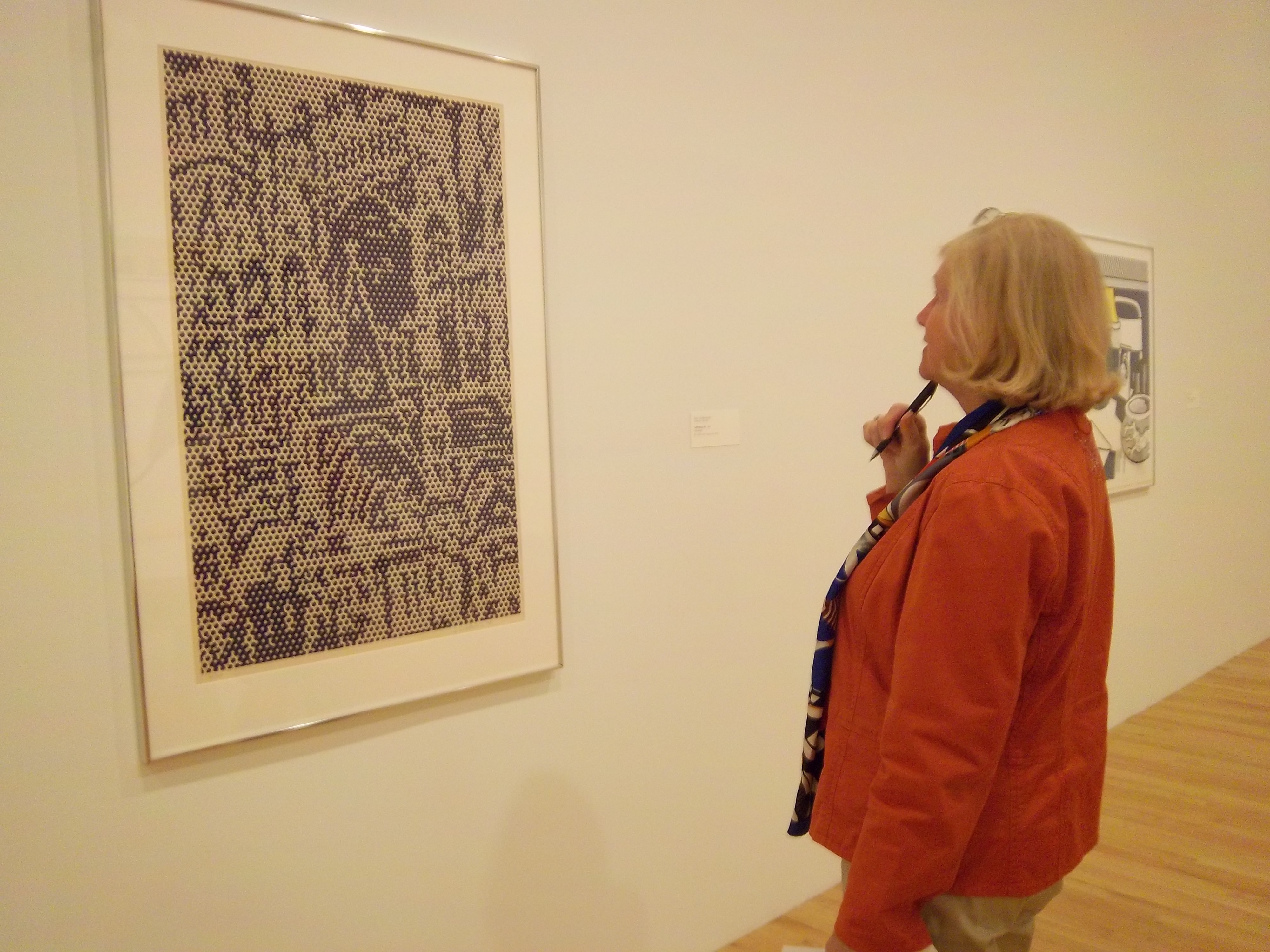
Docent Carol Placido ponders whether this Lichtenstein print matches her state of mind while playing Muse
We also spent time in the galleries playing four games that Tom created for the docents. The games included:
Each of Tom’s games had a defined goal and set of rules that went along with it. Docents, like students, sometimes have a hard time following rules. And as the old saying goes, rules are meant to be broken. Many of the groups altered the rules to create new variations of Tom’s original games. Tom encouraged the docents to give him feedback on his games, and he plans to use their feedback to made additional tweaks to each of the games.
Towards the end of training, docents were given an opportunity to invent games of their own using a set of guidelines that Tom provided. Some of the guidelines included creating a game that was easy to learn but hard to master, designing games for the site in which they will be played, relating games to works of art, and creating cooperative games – everyone participates, and everyone wins. Our docents came up with really great sparks for games, and I’m looking forward to working with Tom and the docents to flesh out their ideas.
If you would like to have an opportunity to experience the world of art and games with Tom Russotti, I encourage you to sign up for the Art & Games teacher workshop on November 12. Teachers will play games that Tom has created, but you will also have an opportunity to invent a game of your own. Our docents loved learning from Tom, and I’m sure that you will, too!
Shannon Karol
Manager of Docent Programs and Gallery Teaching
Mark Bradford opens on October 16 but the installation began a few weeks ago. Below are images of the Barrel Vault installation of Detail, a monumental section of the ark Mithra, which the artist built for Prospect 1, the 2008 New Orleans Biennale, one of the first international art events devised to bring visitors back to that city following Hurricane Katrina.
[slideshow]